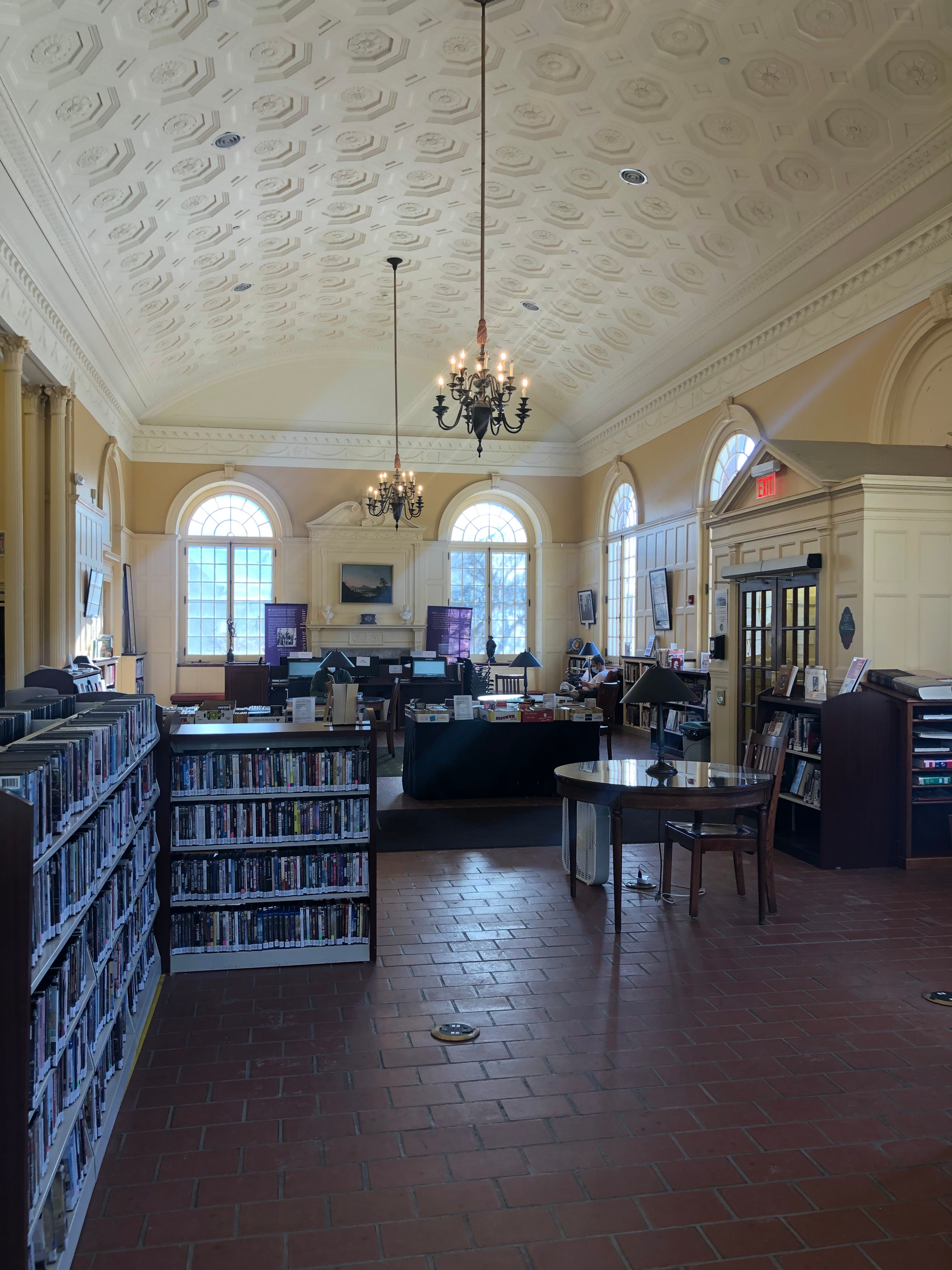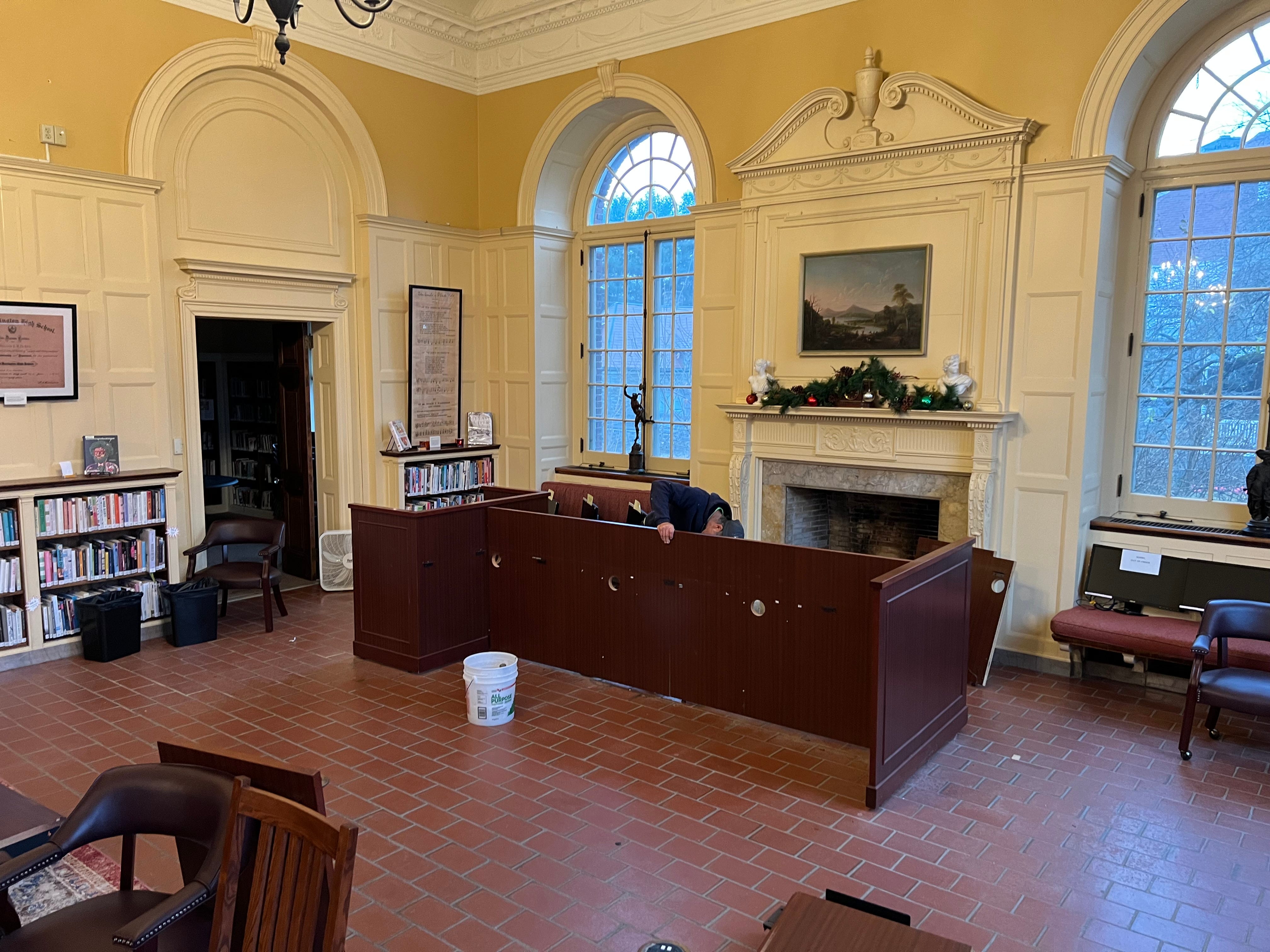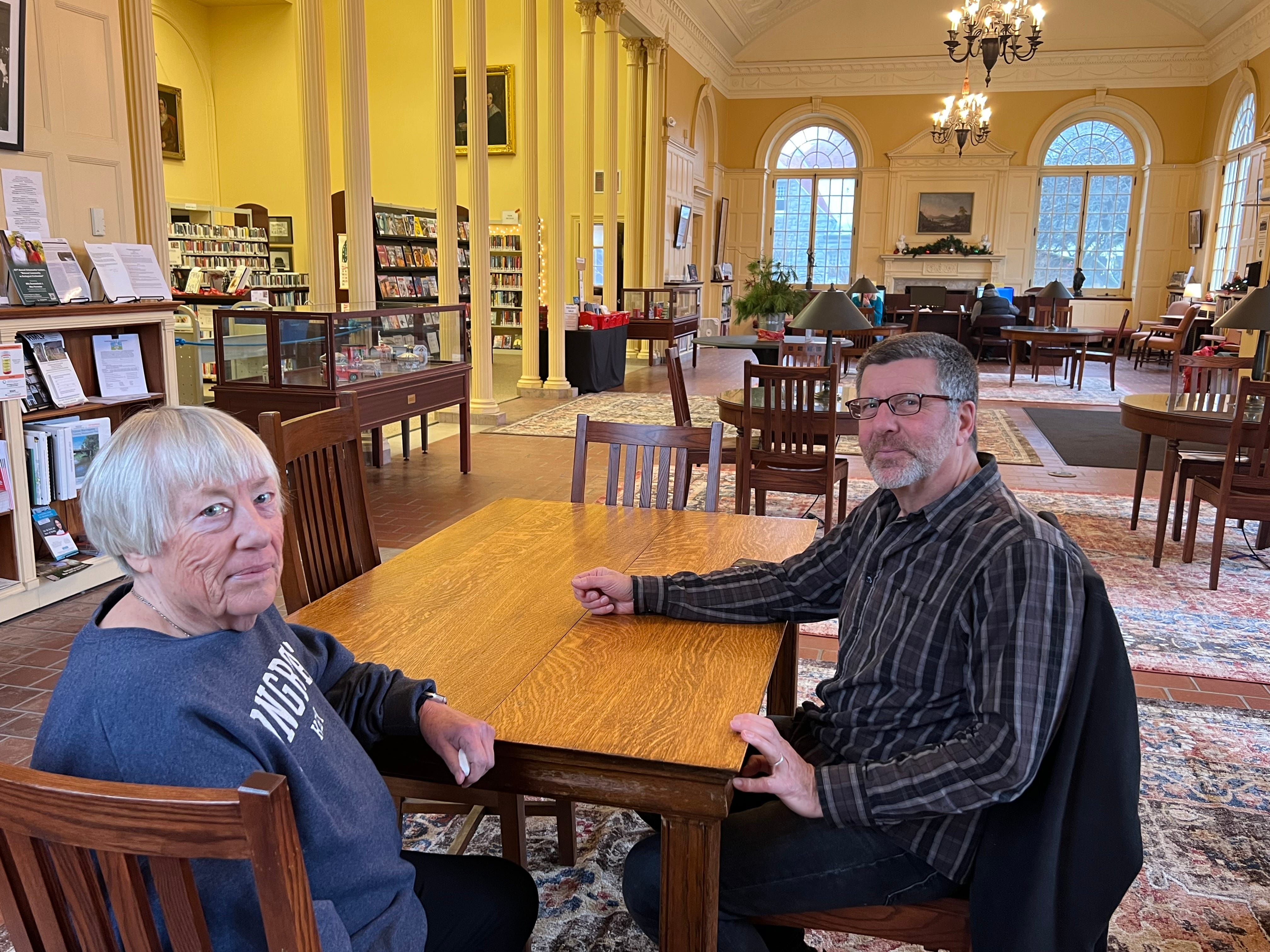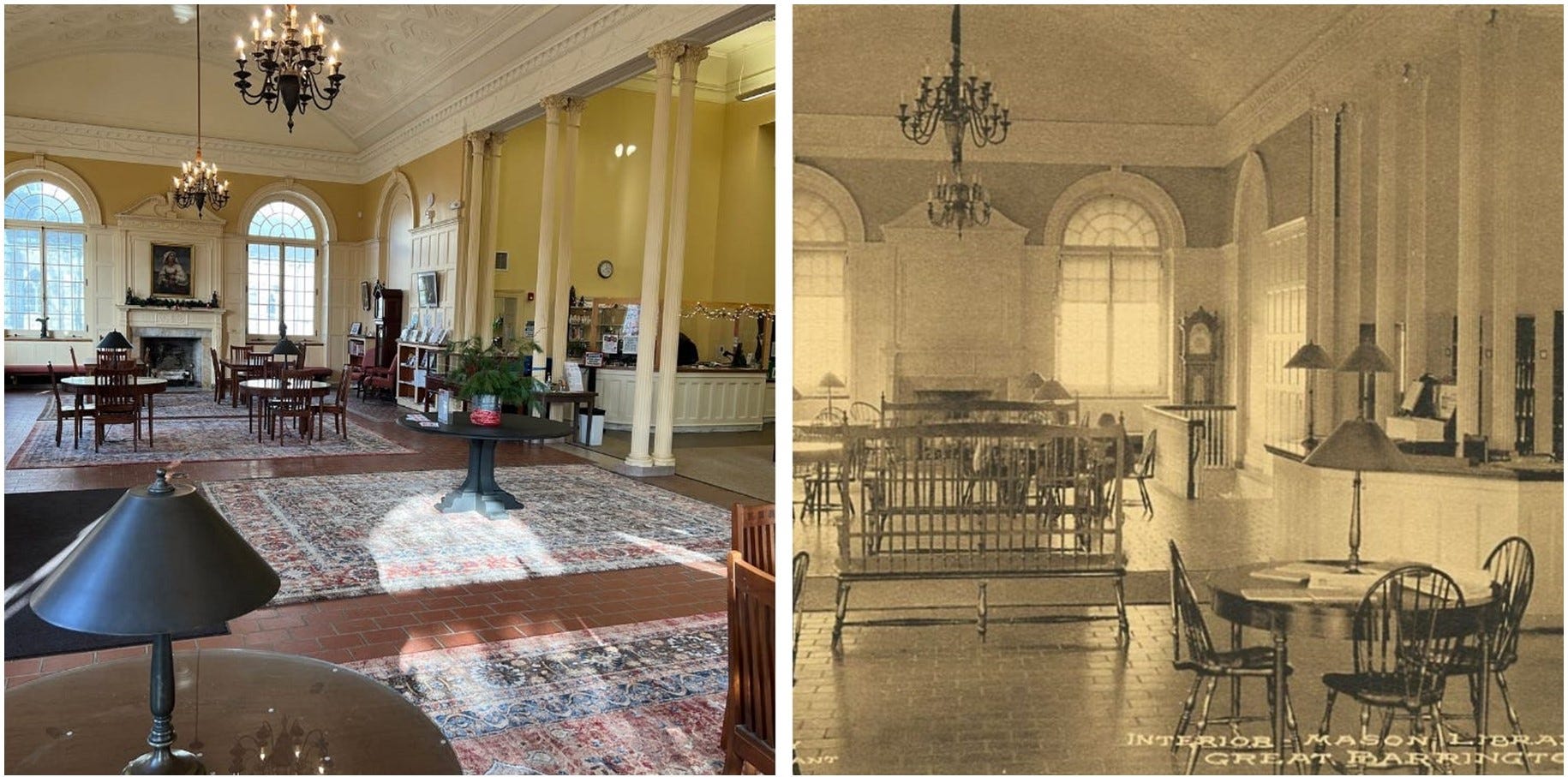With help from a trio of interior designers, and funding from the nonprofit Friends of Great Barrington Libraries, the downtown library's historic reading room gets a worthy overhaul.
∎ ∎ ∎
On a recent Sunday morning, someone walking past the Dresser Avenue entrance of Great Barrington’s Mason Library might have noticed the door was ajar, held open by a folded-up towel. The library is closed on Sundays, but inside, half a dozen people were scurrying around the Georgian-Revival-style building’s large reading room, with its twenty-five-foot ceilings, red-tile floor, and sizable arched windows.
Working quietly—both the early hour and day of the week seemed to hang in the air—and with take-out coffees in hand, they were moving furniture, disconnecting computers, eyeballing distances, pondering layouts, sweeping floors, unrolling Persian-style rugs, and testing out permanent locations for tables and chairs.
The library’s interim director, Donna Brown, arrived at eight-thirty, on her day off, to check on the work. A library employee since 2007, she added her arms and back to the assembled brawn and helped carry heavy wood tables to and fro.
Near one of library’s two fireplaces was Ed Abrahams, a former member of the town’s Select Board and longtime volunteer with Friends of Great Barrington Libraries, and David Gilbert, lead designer at the Scout House furnishings, apparel, home goods, and design boutique on nearby Elm Street. They were both kneeling on the floor, attaching legs to new tables. Once assembled, the tables would replace the laminate-covered-particleboard cubicles where library patrons use computers to access the Internet, check email, do research, skim microfiche, apply for jobs, or just pass the time.
Abrahams and Gilbert had a collection of screws, washers, and nuts spread out alongside some assembly instructions. From one angle, at least, the scene had the look of freshman move-in day.
“Is that tedious?” teased Bobby Houston, the filmmaker, real-estate developer, and local activist—who was coordinating the work—as he looked over their shoulders. He’s one of Scout House’s trio of designer-founders, along with Jennifer Bianco and Kristen Alexander-King. Houston moved to Great Barrington from California in 2005, and, along with his partner, Eric Shamie, launched a business buying, renovating, and selling houses. They’ve worked on twenty-five homes, he told me, and have lived in many of them.
The crew was together that morning because, a few months ago, Houston volunteered to give Mason’s historic reading room a post-pandemic refresh. A nudge came from the town’s library trustees—lately focused on staffing challenges and nascent plans for a major renovation of Housatonic’s Ramsdell Library across town—who want the downtown branch to again host after-hours events. That includes the popular once-a-month film series that regularly filled Mason’s reading room to capacity before it was sidelined by Covid-era precautions.
To hear Houston tell it, there was, indeed, work to do. “Ed said, would you, as a designer with a design business, help us refresh the library? And I said yes. It needs it—bad.” Houston was already involved with the W.E.B. Du Bois Sculpture Project, which will soon place a new Richard Blake statue of the writer and civil-rights leader—a Great Barrington native—in front of the library. Also coming is new landscaping, outdoor seating, and an overhaul of the long-unusable front steps. (“You know the steps are condemned, right?” Houston asked me.)
While he’s not a heavy library user—a little interlibrary loan and a bit of “reading magazines I don’t want to subscribe to, like Rolling Stone and Architectural Digest”—Houston is still at Mason from time to time. “One of the things that’s overlooked is that the library is the best meeting place,” he said, pointing to several cozy rooms available to the public.

He’s long been connected to books, though: For a decade, he owned Local Hero, a bookshop in Ojai, California. And Scout House stocks an eclectic mix of roughly two thousand books for sale—mostly new—in a ground-floor room that’s designed like a home library. (His selection process? “They’re all books I’ve read.”)
That enterprise has other connections to the written word: It’s named for a character in Harper Lee’s “To Kill a Mockingbird,” and it lives in the former home of the Berkshire Record—an 1860 house that Houston purchased after the weekly newspaper folded in 2020.
When he looked around Mason’s reading room with Bianco and Gilbert during their first design consultation, tact was the order of the day. “Rather than shoot our mouths off, we were politic. We said, ‘Ah ha, we see it’s a challenge, we have some ideas,’” Houston said. “We were gentle.”
Not long after that look-see, they came back with some plans and ran it all past Brown and the trustees. “Covid had kind of run roughshod over the interior. It looked like it had been through a rough patch,” he said, his voice reflecting a designer’s practiced mix of diplomacy and emphasis.
Still, Houston was in awe of the place, which was built in 1913. Its design and construction were funded by a fifty-thousand-dollar bequest from Mary A. Mason, a Georgia socialite who relocated to Great Barrington in 1895 with her new husband, a Vermont native named Henry Hobart Mason. “Two fireplaces, a vaulted coffered ceiling, it’s wonderful. So, it wasn’t hard to see what to do,” Houston said.

With new furniture on order, work began. “We went in with a crew on Sundays and Mondays for the library’s ‘Day of Beauty,’” Houston explained. He and some helpers tapped from his renovation-and-design business pulled up old carpet, removed plastic furniture, and piled the detritus in the basement. “We took away everything that had creeped in from Home Depot.”
On that recent Sunday morning, Houston, dressed in a gray shirt, dark-navy jeans, and sneakers, zipped around eyeing various configurations of tables, chairs, and rugs, sometimes rolling and unrolling his shirt cuffs while thinking things through.
The main order of the day—and the final piece of the project—was tackling the computer area at the room’s south end. He wasn’t a fan: “We’re going to take away what we call the ‘computer continent’ and give that area the same aesthetic.” The cubicles were dismantled and their constituent parts vanished; the wood tables assembled earlier by Abrahams and Gilbert took their place.

Funds for the project—the total cost was less than ten thousand dollars—came from the nonprofit Friends group, which raises money largely through a perpetual used-book sale managed by Abrahams and longtime Great Barrington resident, business owner, and activist Holly Hamer. (Books are donated by local residents; they’re not selling titles surreptitiously lifted from the stacks.)
With no events to hold during the pandemic, they saved up some money. Abrahams, ever the fundraiser, was coy about how much remains after the reading-room project: “We never like to say we have money,” he said.
Abrahams and Hamer have been friends—not just friends of the libraries—for a decade and a half. They met in a small-town way: Abrahams, who has lived next to Mason Library since 2000, had tussled with town officials over a few details of the library’s expansion plan in 2005. He was involved in the project for a time as a member of the library’s building committee and later served as a trustee.
In the wake of that turbulence, Hamer reached out. “I went and knocked on his door,” she told me recently about their first meeting. “I said, ‘You’re Ed Abrahams? Oh, I thought you were some kind of ogre.’” Hamer invited him to help with some library-related events, which he did with gusto, and they’ve been friends ever since.
In fact, to say he threw himself into library work would be an understatement. For the last few years, at least, anyone driving down Great Barrington’s Main Street early on weekend mornings, from early spring into the fall, has seen Abrahams lugging boxes and pushing rolling carts filled with books from the library’s basement to the front walkway, ready for browsing by passers-by.
And stop at the library more than a few times and you’re bound to run into Hamer, seated on a stool and patiently organizing book-sale inventory on shelves near the library’s side door.

While those books used to cost a buck or two, during the pandemic the Friends’ sales strategy changed: They now give books away for free. It’s the same deal offered by the library itself, but with no due dates.
Patrons of the book “sale” were asked to make a donation, of any amount, in exchange for used books they took home. Revenue soared. “My hat is off to Ed and Holly, who are tireless, and who work for free, and they raised the money to do this,” Houston said. Lee Bank also makes an annual contribution that underwrites an ongoing giveaway of children’s books on the library’s lower level.
By late morning, the day’s work on the reading room update was wrapping up. Someone from IT was coming to reconnect the computers. Houston would later cut perfectly circular holes in the new rugs to expose power outlets in the floor—available to charge patrons’ devices while they work.
There were a few very-minor crises as things progressed: In winter, would road-salt-covered shoes and boots make short work of a new rug placed near the front door? (They moved it further away.) And one of the new tables arrived without any hardware in the box.
“So, it looks like we’re out of the woods here?” Houston asked later, as Abrahams and Gilbert assembled two tables using just the hardware sent with one. The trick was “every other screw”—for now, until the missing parts arrive—Abrahams told me.

To make room for the new layout, shelving units crammed with DVDs were relocated out of the reading room, where they had migrated over the last couple of years. (Due to be rectified: Houston’s 2004 Oscar-winning documentary short, “Mighty Times: The Children’s March,” is not currently in the library’s DVD collection.)
Years of effort by Abrahams and Hamer—along with the donated time and expertise of Houston, his Scout House compatriots, and the help of Brown, the interim director—have produced a reading room that feels warm and substantial. The vibe is calm and airy with a pleasant studiousness.
Even before work was completed, Hamer cheered the changes. “The rugs seem to make the biggest difference,” she said. “It does make it feel less institutional. And more inviting.” Brown agreed: “It’s just very comfortable and welcoming.”
Houston enjoyed working on the project. “It was fun. The library was receptive, and the trustees were receptive,” he said. Brown, who had final say, went along for the ride. “Before the ‘Day of Beauty,’ Donna was a little nervous,” Houston recalled. “She said, ‘Is this going too fast?’ And I was, like, ‘Hold on, girl, it’ll be fine.’ And she’s been great.”
The refresh fits neatly into a historical continuum: A few months after the library’s summer 1913 opening, Architecture Magazine featured pages of Mason Library glamour shots and a detailed, fold-out drawing of its west-facing façade. Architects from New York’s Blanchard & Barnes had won a competition among eight firms to design the building, and the magazine’s editors were effusive about the result. Mason was “the most attractive small library building in America,” they wrote, and “the most exquisitely complete piece of architectural design which has appeared in a long time.”
More than a century later, that design endures. “We were able to do a lot with a little because the room is remarkable,” Houston said. “It’s the best public space in town.”
∎ ∎ ∎





